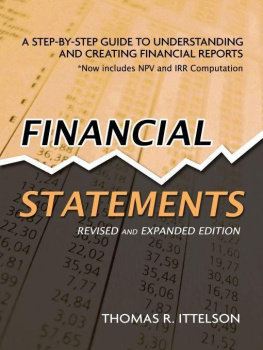How to Analyse Bank Financial Statements
A concise practical guide for analysts and investors
Thomas Padberg
Harriman House
HARRIMAN HOUSE LTD
18 College Street
Petersfield
Hampshire
GU31 4AD
GREAT BRITAIN
Tel: +44 (0)1730 233870
Email: enquiries@harriman-house.com
Website: www.harriman-house.com
First published in Great Britain in 2017
Copyright Thomas Padberg
The right of Thomas Padberg to be identified as the author has been asserted in accordance with the Copyright, Design and Patents Act 1988.
Print ISBN: 978-0-85719-518-0
eBook ISBN: 978-0-85719-519-7
British Library Cataloguing in Publication Data
A CIP catalogue record for this book can be obtained from the British Library.
All rights reserved; no part of this publication may be reproduced, stored in a retrieval system, or transmitted in any form or by any means, electronic, mechanical, photocopying, recording, or otherwise without the prior written permission of the Publisher. This book may not be lent, resold, hired out or otherwise disposed of by way of trade in any form of binding or cover other than that in which it is published without the prior written consent of the Publisher.
Whilst every effort has been made to ensure that information in this book is accurate, no liability can be accepted for any loss incurred in any way whatsoever by any person relying solely on the information contained herein.
No responsibility for loss occasioned to any person or corporate body acting or refraining to act as a result of reading material in this book can be accepted by the Publisher, by the Author, or by the employers of the Author.
For Rhea
Contents
About the author
Thomas Padberg, 41, is a German author. He completed his PhD on the subject of bank financial statement analysis and afterwards worked as a trainer and in-house consultant for many German banks within their specialist departments dedicated to this function. The German edition of his book Bankbilanzanalyse is now in its third edition and has become the standard reference work for the analysis of bank financial statements in Germany. You can contact the author at: tpadberg@trapeza.de
Acknowledgements
This book is the culmination of 20 years of research, accompanied by many changes in accounting rules and financial crises. My greatest debt is to my long-time co-author Thomas Werner, with whom many analysis ideas used in this book were developed.
Many other people played important roles in encouraging, challenging and critiquing me over the years. I would particularly like to thank my brothers Carsten and Christoph, Rolf Beike, Horst Grfer, Thomas Kriete, Petra Oesterwinter, Bettina Schiller, Christiane Sorgenfrei, and Dagmar Tytko.
Last, but not least, I was very lucky to have a wonderful, insightful and extremely supportive editor, Craig Pearce. Craigs comments and suggestions have greatly improved this book, and his support for the project made the last year much more pleasant than it might have been without him.
Preface
What this book covers
This book is about how to analyse bank financial statements.
Bank financial statement analysis has to consider both banking supervision rules and banking accounting rules. These rules are not described in detail here, because this book is about the analysis and not about the rules. Therefore, it is expected that the reader has some background knowledge of these topics.
The data used in this book is mostly from the year 2014. It is already old data, but that does not impact the usefulness of the analysis methods shown in this book. The reader can use these methods to analyse any other bank financial statements.
Who this book is for
This book is written for all of those who are required to analyse banks professionally. The reader should have knowledge of both bank accounting and banking supervision.
How this book is structured
The book is divided into nine chapters. After an introduction in chapter 1, the specifics of bank financial statement analysis are covered in chapter 2. Here I answer the question of why a specific kind of analysis is needed for bank financial statements.
In chapter 3, I look at the accounting rules for banks which have direct implications on the analysis. Not all accounting rules will be mentioned, but only those that are used directly in the analysis.
Segment reporting is the topic of chapter 4. Here I show that segment reporting of banks is used very widely to interpret bank financial statements, but the data in this process can be manipulated very easily.
In chapter 5, I discuss widely used ratios for bank financial statement analysis. I show that most ratios have disadvantages which make them less useful for bank financial statement analysis. However, I show that there is one main ratio that can provide a quick view of the strength of a bank.
Chapter 6 is the most important chapter in the book. It looks at the analysis of the profit and loss accounts of banks.
The equity of banks is then analysed in chapter 7. In this area, banking supervision rules have a big implication on the analysis.
Chapter 8 looks at the stock analysis of banks. The connection between a number of ratios and bank stock prices is shown.
The book ends with chapter 9, which provides some important conclusions.
1. Introduction
In this book, the focus is on banks that are part of the Stoxx 600 Banks index. Other examples will be mentioned too, but mostly the focus is on comparable data from these banks. The constituents of the Stoxx 600 Banks are banks from member states of the European Union, which all use International Financial Reporting Standards (IFRS). This makes it easier to compare them directly.
This does not mean that non-IFRS banks cannot be analysed with the methods shown in this book. What it does mean is that for non-IFRS banks, accounting differences may exist and if this is the case these have to be analysed too.
Example
In Germany, under Handelsgesetzbuch, the German accounting law, it is allowed for banks to depreciate loans or securities up to only 4% of their nominal value. For this depreciation, there does not need to be a reason, such as the increased probability of non-repayment of a loan. Banks can just make the depreciation, without any economic reason. The legislator made this allowance to ensure that banks do not show losses in bad times, helping to avoid a bank run, because they can use these hidden reserves in such bad times.
Comparing German banks following Handelsgesetzbuch and banks following IFRS, these differences have to be eliminated.
Using IFRS does not mean that all parts of the balance sheet or the earnings statement are always comparable. National law can have an influence even on IFRS financial statements.
Example
Greece, Italy, Portugal and Spain give a special guarantee on the deferred tax assets of their banks, with the effect that the deferred tax assets can be used as equity. Most other countries in the EU do not grant this privilege.
In analysis, differences between national laws and how these impact the different numbers in the financial statements have to be recognised if possible.
In fact, the methods of bank analysis can be used on every bank in the world, but the accounting differences between national law and IFRS and their impact on the analysis have to be recognised in every case.
The following table shows the 45 banks of the Stoxx 600 Banks, their market capitalisations (market cap) at 2 October 2015 and their home countries. Their market capitalisation rank is also shown.
Name | Home country | Market cap (Bio. ) | Rank |
Next page





